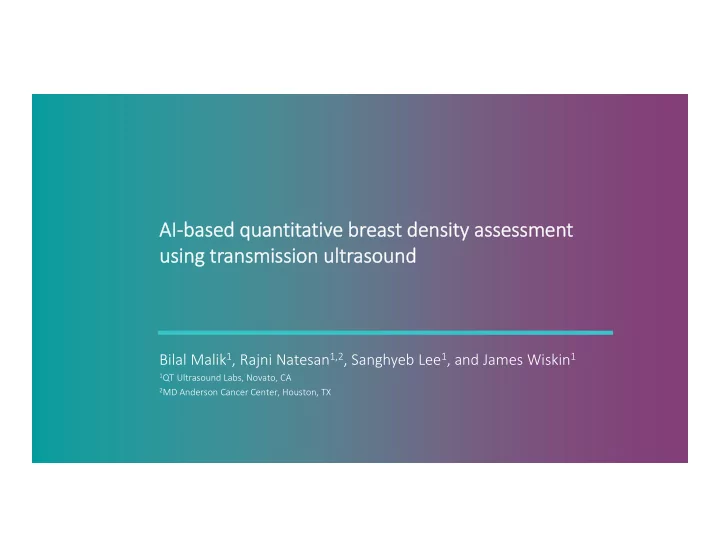

AI‐based quantitative breast density assessment using transmission ultrasound Bilal Malik 1 , Rajni Natesan 1,2 , Sanghyeb Lee 1 , and James Wiskin 1 1 QT Ultrasound Labs, Novato, CA 2 MD Anderson Cancer Center, Houston, TX
Disclosures Principal Scientist, QT Ultrasound LLC Grant funding from National Institutes of Health (NIH)
Purpose Growing body of evidence indicates that breast density is one of the most important independent risk factors of breast cancer Currently, mammography is the only FDA‐cleared means to evaluate breast density in a general screening population. We present 3D transmission ultrasound as a method to visualize and differentiate fibroglandular tissue within the breast and use a fully automated segmentation method machine learning‐based method to quantitatively assess the breast density
QT Scanner – transmission and reflection ultrasound
QT speed of sound and reflection images
3D image volume of speed of sound and reflection Speed of Sound Reflection
Transmission & Reflection: normal breast anatomy Transmission > Reflection >
Tissue segmentation algorithm Segment breast from surrounding water using attenuation images Determine ‘border’ pixels based on proximity • Fuzzy clustering into two categories Segmentation of high‐ • Membership map speed breast tissue from generation the total breast volume • Thresholding Calculate breast density
Testing on tissue phantoms Density based on theoretical volume = 7.1% Density based on QBD = 7.6%
Testing on clinical images • Application of algorithm on 100 unilateral breast scans • Mammography performed within 90 days of transmission imaging • Both QBD and VolparaDensity TM (v3.1) scores were available. • Correlation quantified using Spearman coefficient
Segmentation of fibroglandular tissue QBD= 10.9% QBD= 29.5% QBD= 62.4% Wiskin et al., Medical Physics, 2019, in press
Correlation of QBD with VolparaDensity • Spearman r = 0.94 (95% CI: 0.91‐ 0.96); p<0.0001) • Deming linear regression shows a relationship of VolparaDensity = 0.53(QBD) ‐ 0.87
QBD relationship with VolparaDensity similar to MRI Volpara %FGV MRI %FGV Ref: Wang et al., PLoS One, 8(12), 2013
Validation of segmentation algorithm using large format histology H&E fibroglandular volume = 42.3 % TU fibroglandular volume = 45.1 %
Validation of segmentation algorithm using UV microscopy QT speed of sound image – QBD= 34.7% MUSE image – equivalent breast density = 37.9%
Precision of QBD measurement • Scanned a single breast/patient ten times • Calculated QBD for individual scans • Mean QBD value = 9.4 %; Standard deviation = 0.2 %
Volumetric rendering of segmented breast tissue
Conclusions The presented segmentation method can accurately identify the fibroglandular tissue volume within the whole breast. The results indicate that breast density as assessed by fully automated means using TU can be of significant clinical value and play an important role in breast cancer risk assessment.
Recommend
More recommend